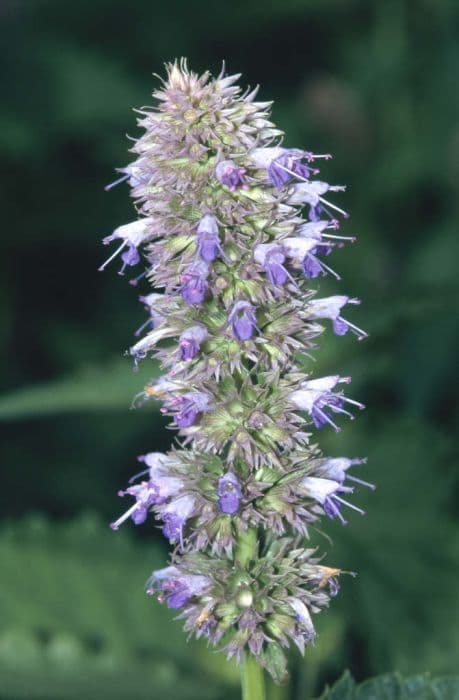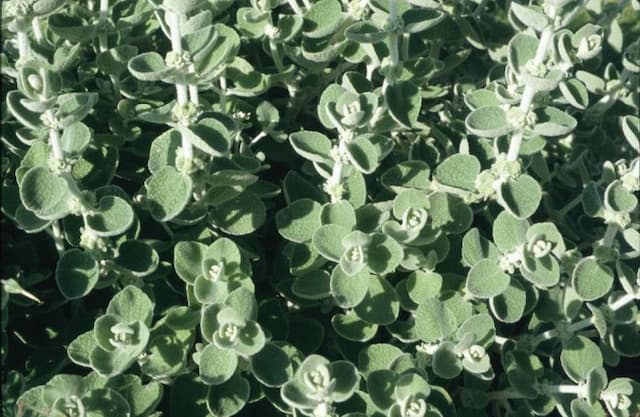Tube Clematis Phlomis tuberosa

ABOUT
Phlomis tuberosa, also commonly known as Jerusalem Sage, is a perennial plant that is recognized by its striking appearance. It features a robust and upright structure with branching, square stems that give it a sturdy look. The leaves of Jerusalem Sage are heart-shaped or ovate and are characterized by their textured, wrinkled surface with a slightly hairy feel. They emit a strong aroma when crushed. The foliage tends to have a grey-green color, creating a nice contrast with the flowers. The flowering season brings whorls of tubular flowers that are stacked in tiers, one above the other, along the upper part of the stems. These flowers are typically a vibrant shade of pink or a mauve-pink color, which adds a pop of visual interest to the plant's overall greenery. The blossoms of Jerusalem Sage are highly attractive to pollinators such as bees and butterflies, making it an excellent plant for a wildlife garden. Once the flowering period concludes, the plant may produce seed heads that add a textural dimension to the plant's profile in the garden. Overall, Jerusalem Sage carries a distinctive form and texture that makes it a prominent plant in any garden setting, offering a mix of aromatic foliage and eye-catching blooms that last for a considerable period during the warmer months.
About this plant
 Names
NamesFamily
Lamiaceae.
Synonyms
Tuborous Jerusalem Sage, Hardy Jerusalem Sage.
Common names
Phlomis tuberosa L.
 Toxicity
ToxicityTo humans
Phlomis tuberosa, commonly known as the Balkan clary, is not widely documented as a poisonous plant to humans. However, as with many plants, individuals may experience varying sensitivity or allergic reactions. If the Balkan clary is indeed toxic and ingested, symptoms could include gastrointestinal distress such as nausea, vomiting, diarrhea, and abdominal pain. More severe reactions could potentially involve neurological symptoms, depending on the toxic compounds present in the plant. In the absence of specific toxicity information, it is generally advisable to avoid ingesting any part of plants not known to be edible.
To pets
The Balkan clary is not commonly listed among plants that are toxic to pets, but the absence of evidence is not evidence of absence. Pets may have sensitivities to plant compounds that are not harmful to humans. Signs of possible poisoning in pets, if the plant were toxic, might include salivation, vomiting, diarrhea, lethargy, or more serious gastrointestinal upset. As with any non-food plant, it's best to prevent pets from ingesting parts of the Balkan clary to ensure their safety. If you suspect your pet has ingested any part of this plant and is showing signs of distress, please consult a veterinarian.
 Characteristics
CharacteristicsLife cycle
Perennials
Foliage type
Deciduous
Color of leaves
Green
Flower color
Pink
Height
2-3 feet (0.6-0.9 meters)
Spread
2 feet (0.6 meters)
Plant type
Herb
Hardiness zones
5
Native area
Eurasia
Benefits
 General Benefits
General Benefits- Attracts pollinators: Phlomis tuberosa, commonly known as the Jerusalem Sage, is known for attracting bees, butterflies, and other beneficial insects to the garden due to its nectar-rich flowers.
- Drought tolerant: Jerusalem Sage has the ability to withstand dry conditions, making it suitable for xeriscaping and low-water gardens.
- Deer resistant: The plant is not favored by deer, which can help prevent damage to gardens in areas where deer are prevalent.
- Long blooming season: Phlomis tuberosa has a lengthy flowering period that often extends from late spring to early summer, adding long-term visual interest to landscapes.
- Architectural structure: The plant's upright form and whorls of flowers can add structural interest to garden design.
- Low maintenance: Once established, Jerusalem Sage typically requires minimal care beyond occasional watering and pruning to maintain its appearance.
- Erosion control: The spreading and clumping growth habit of Phlomis tuberosa can help stabilize soil and reduce erosion on slopes and banks.
 Medical Properties
Medical Properties- Anti-inflammatory: Phlomis tuberosa may have properties that help reduce inflammation.
- Antimicrobial: It might contain substances that have the potential to combat certain bacteria and fungi.
- Antioxidant: The plant could have constituents that act as antioxidants, helping to neutralize harmful free radicals in the body.
- Wound healing: There are claims that it may promote wound healing, although more research is needed to confirm this.
- Analgesic: Traditional uses suggest it could have pain-relieving properties.
 Air-purifying Qualities
Air-purifying QualitiesThis plant is not specifically known for air purifying qualities.
 Other Uses
Other Uses- Phlomis tuberosa, commonly known as Jerusalem Sage, can be used in flower arrangements for both fresh and dried displays due to its unique sphere-shaped blooms and robust stems.
- The fuzzy leaves of Jerusalem Sage can be used in crafts for making natural textures or patterns.
- The stems of Jerusalem Sage are sturdy and can be used as natural skewers for grilling small pieces of meat or vegetables.
- Jerusalem Sage can also serve as a companion plant to protect vulnerable plants as its thick foliage can provide shade and shelter.
- The plant's dried seed heads can be used as part of a natural bird feeder to attract and feed birds in the winter.
- Jerusalem Sage's tall and striking flower stalks make them an excellent choice for creating visual barriers or privacy screens in gardens.
- The nectar-rich flowers can be a valuable addition to a garden designed to attract pollinators like bees and butterflies.
- Its resilient nature makes Jerusalem Sage a good candidate for erosion control on slopes or banks.
- The plant can be used in potpourri mixes, offering an herbal scent and added texture.
- In art, the unique form of Jerusalem Sage can be used for botanical illustration or nature-inspired design elements.
Interesting Facts
 Feng Shui
Feng ShuiThe Phlomis tuberosa is not used in Feng Shui practice.
 Zodiac Sign Compitability
Zodiac Sign CompitabilityThe Phlomis tuberosa is not used in astrology practice.
 Plant Symbolism
Plant Symbolism- Resilience - Phlomis tuberosa, commonly known as Jerusalem Sage, is valued for its ability to thrive in poor soil conditions and resist drought, symbolizing the ability to withstand adversity and maintain strength.
- Protection - The thick and woolly nature of Jerusalem Sage's leaves has been associated with a natural barrier, representing protection and safety.
- Healing - Historically, Jerusalem Sage has been used in herbal remedies for its medicinal properties, symbolizing healing and well-being.
- Persistence - With its robust and persistent growth habits, Jerusalem Sage symbolizes persistence and the determination to grow despite challenges.
- Wisdom - The name "sage" in Jerusalem Sage is often connected with wisdom, as sage has been a symbol of wisdom and immortality in different cultures.
 Water
WaterJerusalem Sage prefers moderate watering, and the frequency depends on the climate and weather conditions. In general, during the growing season in spring and early summer, water the plant thoroughly once a week, ensuring that the soil is moist but not waterlogged. Provide approximately 1 to 1.5 gallons per watering session. During the hot, dry periods, you may need to increase watering to twice a week. Cut back on watering as the plant goes dormant in late summer and fall, reducing to once every two weeks or when the soil feels dry to the touch several inches below the surface.
 Light
LightJerusalem Sage thrives in full sun to partial shade. The best spot for this plant is where it can receive at least six hours of direct sunlight per day, though it can tolerate some afternoon shade. An east-facing garden that gets morning sun or a south-facing spot where it can bathe in sunlight throughout the day would be ideal for this perennial.
 Temperature
TemperatureJerusalem Sage is quite temperature resilient, capable of surviving in a range of conditions with the hardiness zones usually cited between 4 and 9. The ideal temperature conditions for the plant are between 60 and 75 degrees Fahrenheit. However, it can withstand minimum temperatures down to -30 degrees Fahrenheit and maximum temperatures well above 100 degrees Fahrenheit as long as the soil moisture levels are appropriate.
 Pruning
PruningPruning Jerusalem Sage promotes healthier growth and prevents the plant from becoming leggy. Prune the plant in early spring to remove any dead or damaged stems and shape the plant. Additionally, after blooming, cut back the flower stalks to encourage a tidy appearance and possibly a second bloom. Pruning once a year is usually adequate, but always after the main blooming period.
 Cleaning
CleaningAs needed
 Soil
SoilJerusalem Sage thrives best in well-drained soil with a slightly alkaline pH (around 7.0 to 8.0). A soil mix containing equal parts loam, sand, and a small amount of compost or organic matter would be ideal to ensure proper drainage and fertility.
 Repotting
RepottingJerusalem Sage does not require frequent repotting as it prefers to be left undisturbed once planted. Repotting every 2 to 3 years, or when it outgrows its pot, is sufficient.
 Humidity & Misting
Humidity & MistingJerusalem Sage is quite tolerant of various humidity levels and does well in average garden conditions. It does not require any specific humidity level to thrive.
 Suitable locations
Suitable locationsIndoor
Grow in bright light, minimal watering, and well-drained soil.
Outdoor
Full sun, well-drained soil, drought-tolerant once established.
Hardiness zone
5-9 USDA
 Life cycle
Life cyclePhlomis tuberosa, commonly known as the tuberous Jerusalem sage, begins its life cycle as a seed that germinates in warm, moist soil conditions. After germination, seedlings emerge and develop into a rosette of basal leaves during their first year. In the second year, the plant produces a flowering stalk with whorled clusters of pink to purple flowers, attracting pollinators and resulting in seed production. Once pollinated, the flowers develop into small nutlets that fall to the ground and can produce new plants the following season. Throughout these stages, the plant develops a tuberous root system that allows it to survive in periods of drought. As a perennial, Phlomis tuberosa may live and reproduce for several years, with the vegetative growth occurring each spring, followed by summer flowering.
 Propogation
PropogationPropogation time
Spring-Early Summer
Phlomis tuberosa, commonly known as the tuberous Jerusalem sage, is best propagated by division, which is typically carried out in early spring or autumn. To propagate by division, carefully dig up an established clump and gently separate it into smaller sections, ensuring that each new section has a portion of the root system. These divisions can then be replanted directly into the garden or into pots to establish before transplanting. It's important to water the new plants thoroughly after planting and continue to provide moisture until they are well established. This method allows for the quick establishment of new plants that will be genetically identical to the parent plant.









